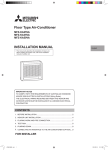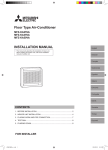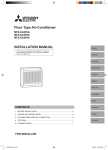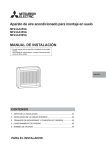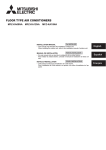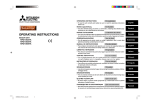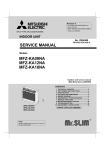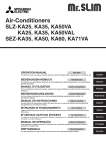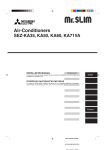Download Mitsubishi MFZ-KA50VA - E4MFZ-KA35VA Installation manual
Transcript
Floor Type Air-Conditioner MFZ-KA25VA MFZ-KA35VA MFZ-KA50VA [FLARE CONNECTION TYPE] CONTENTS 1. THE FOLLOWING SHOULD ALWAYS BE OBSERVED FOR SAFETY ........................................................................................... 2 HFC utilized R410A INSTALLATION MANUAL 2. INSTALLATION DIAGRAM & ACCESSORIES ................................ 2 3. SELECTING THE INSTALLATION LOCATION ................................ 3 4. INDOOR UNIT INSTALLATION ....................................................... 4 5. INDOOR/OUTDOOR UNIT CONNECTION FINISHING AND TEST RUN ....................................................................................... 9 6. FOR MOVEMENT AND MAINTENANCE ...................................... 11 • This manual only describes the installation of indoor unit. When installing the outdoor unit, refer to the installation manual of outdoor unit. FOR INSTALLER IMPORTANT NOTES TO COMPLY WITH THE REQUIREMENTS OF AUSTRALIAN STANDARD AS/NZS 3000 ELECTRICAL INSTALLATIONS (Wiring Rules), THE ELECTRICAL WIRING REQUIRED BETWEEN THE INDOOR AND OUTDOOR UNITS MUST BE INSTALLED BY A LICENCED ELECTRICAL CONTRACTOR. 1. THE FOLLOWING SHOULD ALWAYS BE OBSERVED FOR SAFETY 2. INSTALLATION DIAGRAM & ACCESSORIES 100 mm or more • Be sure to read “THE FOLLOWING SHOULD ALWAYS BE OBSERVED FOR SAFETY” before installing the air conditioner. • Be sure to observe the cautions specified here as they include important items related to safety. • The indications and meanings are as follows. Warning: Could lead to death, serious injury, etc. Caution: Could lead to serious injury in particular environments when operated incorrectly. • After reading this manual, be sure to keep it together with the instruction manual in a handy place on the customer’s site. 100 mm Warning or more 100 m m or m ■ Perform electrical work according to the installation manual and be sure to use an exclusive circuit. If the capacity of the power circuit is insufficient or there is incomplete electrical work, it could result in a fire or an electric shock. ■ Attach the electrical part cover to the indoor unit and the service panel to the outdoor unit securely. If the electrical part cover in the indoor unit and/ or the service panel in the outdoor unit are not attached securely, it could result in a fire or an electric shock due to dust, water, etc. ■ Be sure to use the part provided or specified parts for the installation work. The use of defective parts could cause an injury or leakage of water due to a fire, an electric shock, the unit falling, etc. ■ Be sure to cut off the main power in case of setting up the indoor electronic control P.C. board or wiring works. It could cause an electric shock. ■ The appliance shall be installed in accordance with national wiring regulations. ■ When installing or relocating the unit, make sure that no substance other than the specified refrigerant (R410A) enters the refrigerant circuit. Any presence of foreign substance such as air can cause abnormal pressure rise or an explosion. ore Piping can be directed towards rear, right, downward, left or left-rear directions. Left-rear Rear Left D C H Left-Downward C Downward Lock the catch. G E B F 2 3 Separate the 2 connecting pipes and apply insulation individually. 6 SUZ-KA25/35 VA Caution ■ Earth the unit. Do not connect the earth to a gas pipe, water pipe, lightning rod or telephone earth. Defective earthing could cause an electric shock. ■ Do not install the unit in a place where an inflammable gas leaks. If gas leak and accumulate in the area surrounding the unit, it could cause an explosion. ■ Install an earth leakage breaker depending on the installation place (Where it is humid). If an earth leakage breaker is not installed, it could cause an electric shock. 7 150 mm or below from the floor ■ Do not install it by yourself (customer). Incomplete installation could cause injury due to fire, electric shock, the unit falling or leakage of water. Consult the dealer from whom you purchased the unit or special installer. ■ Install the unit securely in a place which can bear the weight of the unit. When installed in an insufficient strong place, the unit could fall causing injury. ■ Use the specified wires to connect the indoor and outdoor units securely and attach the wires firmly to the terminal block connecting sections so the stress of the wires is not applied to the sections. Incomplete connecting and fixing could cause a fire. ■ Do not use intermediate connection of the power cord or the extension cord and do not connect many devices to one AC outlet. It could cause a fire or an electric shock due to defective contact, defective insulation, exceeding the permissible current, etc. ■ Check that the refrigerant gas does not leak after installation has completed. If refrigerant gas leaks indoors, and comes into contact with the fire of a fan heater, space heater, stove, etc., harmful substances will be generated. ■ Perform the installation securely referring to the installation manual. Incomplete installation could cause a personal injury due to fire, electric shock, the unit falling or leakage of water. Be careful the drain hose is not raised. 8 mm thickness thermal insulation plastic I A ■ Perform the drainage/piping work securely according to the installation manual. If there is a defect in the drainage/piping work, water could drop from the unit and household goods could be wet and damaged. ■ Fasten a flare nut with a torque wrench as specified in this manual. When fastened too tight, a flare nut may broken after a long period and cause a leakage of refrigerant. B 2 When the piping is to be attached to a wall containing metals (tin plated) or metal netting, use a chemically treated wooden piece 20 mm or thicker between the wall and the piping or wrap 7 to 8 turns of insulation vinyl tape around the piping. 3. SELECTING THE INSTALLATION LOCATION ACCESSORIES PART TO BE PROVIDED AT YOUR SIDE 3-1 Check the following parts before installation. Optional extension pipe • Where airflow is not blocked. • Where cool air spreads over the entire room. • Maximum refrigerant piping length between indoor unit and outdoor unit is 20 m (for 25/35) 30 m (for 50) and the difference of height of both units is 12 m (for 25/35) 15 m (for 50). • Rigid wall without vibration. • Where it is not exposed to direct sunshine. • Where easily drained. • At a distance 1 m or more away from your TV and radio. Operation of the air conditioner may interfere with radio or TV reception in areas where reception is weak. An amplifier may be required for the affected device. • In a place as far away as possible from fluorescent and incandescent lights (so the infrared remote control can operate the air conditioner normally). • Where the air filter can be removed and replaced easily. <Indoor unit> 1 2 3 4 5 6 7 8 9 0 A B C Drain hose Remote controller holder Fixing screw for 2 3.5 × 16 mm (Black) Pipe cover Band Battery (AAA) for remote controller Indoor unit mounting bracket Fixing screw for 7 4 × 25 mm Wood screw for the indoor unit fixation Washer of 9 Felt tape (Used for left or left-rear piping) Wireless remote controller Air cleaning filter 1 1 2 1 2 2 1 5 4 4 1 1 1 A B C D E F G H I J Indoor/outdoor unit connecting wire 1 (4-core 1.5 mm2) Extension pipe 1 Wall hole sleeve 1 Wall hole cover 1 Pipe fixing band 2 to 5 (The quantity depends on the pipe length.) Fixing screw for E 4 × 20 mm (The quantity 2 to 5 depends on the pipe length.) Piping tape 1 Putty 1 Drain hose (or soft PVC. hose, 15 mm inner dia.) 1 or 2 Refrigeration oil 1 3-2 • Mounting Select a position about 1.2 m above the floor, check that signals from the controller are surely received by the indoor unit from that position (‘beep’ or ‘beep-beep’ receiving tone sounds), attach remote controller holder 3 to a pillar or wall, then set the wireless remote controller 6. • This unit has flared connections on both indoor and outdoor sides. • Refrigerant pipes are used to connect the indoor and outdoor units as shown in the figure below. • Insulate both refrigerant and drain piping completely to prevent condensation. In rooms where inverter type fluorescent lamps are used, the signal from the wireless remote controller may not be received. PIPING PREPARATION 1 Table below shows the specifications of pipes commercially available. For gas Outside diameter 6.35 mm KA25/35 9.52 mm KA50 12.7 mm WIRELESS REMOTE CONTROLLER MOUNTING • Place of mounting - Where it is easy to operate and easily visible. - Where children cannot touch. FLARED CONNECTIONS Pipe For liquid INDOOR UNIT Insulation thickness 8 mm 8 mm 8 mm Insulation material Heat resisting foam plastic 0.045 specific gravity • Use a copper pipe or a copper-alloy seamless pipe with a thickness of 0.8 mm (for ø6.35 and ø9.52) or 1.0 mm (for ø12.7). Never use any pipe with a thickness less than 0.8 mm (for ø6.35 and ø9.52) or 1.0 mm (for ø12.7), as the pressure resistance is insufficient. 2 Ensure that the 2 refrigerant pipes are well insulated to prevent condensation. 3 Refrigerant pipe bending radius must be 100 mm or more. Caution: Be sure to use the insulation of specified thickness. Excessive thickness may cause incorrect installation of the indoor unit and lack of thickness may cause dew drippage. 3 4. INDOOR UNIT INSTALLATION 4-1 4-3 INDOOR UNIT MOUNTING BRACKET INSTALLATION • Install the bracket firmly to the wall structure (stud, etc.). • Use a level to install the mounting bracket horizontally. • Install the indoor unit 150 mm or below from the floor. INDOOR UNIT INSTALLATION • Hook the top of the indoor unit on the indoor unit mounting bracket 7. • Use the included wood screws 9 and washer 0, and fasten the indoor unit at 2 locations (e) each at the top and the middle of the unit. 674 131 (700 ) Indoor unit mounting bracket 7 4-2 To prevent the indoor unit mounting bracket 7 from vibrating slightly, be sure to fasten the bracket at the holes indicated by b. In addition, fasten the bracket at the holes indicated by f if possible. 333 0 20 363 586 (600) 14 131 INDOOR UNIT PREPARATION 210 • Press the 2 positions indicated by the arrows e and open the front grille. • Open the front grille and remove the two screws. • Open the horizontal vane for the upper air outlet, push the top of the front panel in three locations, and then pull the top of the grille away from the indoor unit. • Lift up the front grille to remove it. 4-4 CONNECTING WIRE SPECIFICATIONS • Use special room air conditioning circuit. Indoor/outdoor unit connecting wire Specification Cable 4-core 1.5 mm2, in conformity with Design 245 IEC 57. Warning: Never cut the indoor and outdoor unit connecting wire and connect it to other wires. It may cause a fire. Screws 4 4-5 INDOOR AND OUTDOOR CONNECTING WIRE CONNECTION 4-6 You can connect indoor/outdoor lead wire without removing the front grille. 1 Open the front grille. 2 Remove two screws holding the cabinet, then remove the front panel. 3 Remove one screw holding the electrical cover, then remove the cover. 4 Remove one screw holding the cord clamp, then remove the clamp. 5 Pass the indoor/outdoor unit connecting wire and fix the wire to the terminal block. 6 Secure the indoor/outdoor unit connecting wire and the earth wire with the cord clamp. 7 Re-install the fixture and electrical cover securely. • These models are equipped with an auto restart function. If you do not want to use this function, please consult the service representative because the setting of the unit needs to be changed. • When the indoor unit is controlled with the remote controller, the operation mode, the set temperature, and the fan speed are memorized by the indoor electronic control P.C. board. The auto restart function sets to work the moment the power has restored after power failure, then, the unit will restart automatically. If the unit is operated in “AUTO” mode before power failure, the operation mode (COOL, DRY or HEAT) is not stored in the memory. When the main power is turned on, the unit decides the operation mode by the initial room temperature at restart and starts operation again. Indoor terminal block Operation 1 If the main power has been cut, the operation settings remain. 2 When three minutes have passed after power was restored, the unit will restart automatically according to the memory. Electrical cover Notes: • The operation settings are memorized when 10 seconds have passed after the remote controller was operated. • If the main power is turned off or a power failure occurs while AUTO START/STOP timer is active, the timer setting is cancelled. As these models are equipped with an auto restart function, the air conditioner starts operating with timer cancelled at the same time that power is restored. • If the unit has been off with the remote controller before power failure, the auto restart function does not work as the power button of the remote controller is off. • To prevent breaker off due to the rush of starting current, systematize other home appliances not to turn on at the same time. Fixing screw Cord clamp Never fail to hook the right claw on the VA clamp to secure indoor/outdoor unit connecting wire A. Securely push the wire into the terminal block until no part of its core is appeared. Indoor/outdoor unit connecting wire A Warning: • Use the indoor/outdoor unit connecting wire that meets the Standards to connect the indoor and outdoor units and fix the wire to the terminal block securely so that no external force is conveyed to the connecting section of the terminal block. Incomplete connection or fixing of the wire could result in a fire. • Attach the cord clamp securely. If it is attached incorrectly, it could result in a fire or an electric shock due to dust, water, etc. Loosen terminal screw. Indoor terminal block 15 mm 35 mm Earth wire (green/yellow) Indoor/outdoor unit connecting wire A 4-core 1.5 mm2 Lead wire Terminal block <Connection details> • • • • • • AUTO RESTART FUNCTION Outdoor terminal block Caution: Be careful not to make mis-wiring. Firmly tighten the terminal screws to prevent them from loosening. After tightening, pull the wires lightly to confirm that they do not move. If the connecting wire is incorrectly connected to the terminal block, the unit does not operate normally. If an earth is incorrect, it may cause an electric shock. Make earth wire a little longer than the others. (more than 55 mm) 5 4-7 MAKING HOLES IN THE WALL AND FLOOR 4-8 PIPING INSTALLATION CONNECTING PIPE INSTALLATION • Install the connecting pipes so that the piping can move slightly to the front, back, left, and right. MAKING HOLES 1 Make ø65 mm holes (ø75 mm for KA50) that are approximately 5–7 mm deep and angled slightly downward outward from the room. 2 Insert the wall hole sleeves C into the holes. Wall hole Wall thickness 65 mm dia. (ø75 mm for KA50) One scale Cut with 1 extra scale length. (Indoor side) (Wall hole cross section) Wall hole sleeve C FOR RIGHT DOWNWARD PIPING Caution: Be sure to use the wall hole sleeves C. Otherwise, the indoor/outdoor unit connecting wires may contact a metal object in the wall or, in the case of hollow walls, small rodents may gnaw on the wires, resulting in a very dangerous situation. Pipe covers 4 DETERMINING HOLE POSITIONS • The areas where the piping can be routed are indicated with oblique lines in the figure. FOR RIGHT DOWNWARD OR LEFT DOWNWARD PIPING (The following figure is a view of the bottom of the indoor unit from above.) 61 73 60 31 200 14 150 75 168 62 600 496 700 23 60 78 19 60 599 FOR RIGHT PIPING 97 80 FOR LEFT PIPING • Be sure to insulate the connecting pipes and place them near the rear of the indoor unit so that they do not contact the front panel. • Be careful not to crush the connecting pipes when bending them. When the unit is installed on the wall. When the unit is installed on the floor. 60 19 288 131 Remove the cover. 147 700 131 Bands 5 Bands 5 105 FOR REAR OR LEFT-REAR PIPING (The following figure is a front view of the indoor unit installation location.) FOR PIPING OTHER THAN RIGHT DOWNWARD 60 SEALING THE HOLES • Use putty or a caulking compound to seal the holes. 6 4-9 FOR LEFT OR LEFT-REAR PIPING Bundle the connecting pipes and drain hose together, and then wrap them in felt tape B. Make sure that the drain hose is not routed upward. EMBEDDING THE INDOOR UNIT IN A WALL • When installing a grating, use a grating with narrow upper and lower horizontal bars so that the airflow from the upper and lower air outlets does not contact the bars. If the horizontal bars will block the lower air outlet, use a stand, etc., to adjust the height of the indoor unit. If the upper or lower air outlet is blocked, the air conditioner will not be able to cool or warm the room well. • Do not block the receiver with the grating. Otherwise, the grating will interfere with the remote controller signal and significantly reduce the distance and area (angle) from which the signals can be received. • Use a grating with vertical bars, etc., that has at least 75% open area. If the grating has horizontal bars or if the open area is less than 75%, performance could be reduced. • When the indoor unit is embedded in a wall (built-in), the time it takes for the room temperature to reach the set temperature will increase. 100 or more Upper air outlet Start wrapping the piping tape D around the pipes and hose 10 mm inside the indoor unit. 100 or more Receiver Indoor unit Grating 100 or more Fasten the end of the felt tape B with a bandage stopper. Felt tape B 65 Wrap the felt tape B tightly around the pipes and hose starting near where the pipes and hose are routed from the indoor unit. (The overlap width of the felt tape B should not be more than 1/2 of the tape width.) 475 14 65 52 26 60 Lower air outlet 20-35 Cut and use the lower side panels on the left and right sides of the indoor unit as shown below. Smooth the cut edges of the side panels so that they will not damage the insulation coating. • For left or right piping • Installing flush against a wall with molding EMBEDDED INDOOR UNIT SETTING (MUST BE PERFORMED) • When embedding the indoor unit in a wall, restrict the movement of the horizontal vane for the upper air outlet so that it only operates horizontally. • If this setting is not performed, heat will build up in the wall and the room will not be cooled or warmed properly. • Cut the wires on the left and right sides of JRFBL using a pair of nippers, etc., as shown below. Control board Cut JR24 JRFBL Molding Cut the wires on both ends. Cut the lower side panels to match the height of the molding. Cut the JRFBL wires. 7 • When routing the drain piping, make sure that the drain hose 1 is routed as shown. (Fig. 8) • Insert the drain hose all the way to the base of the drain pan. (Fig. 9) Make sure that the drain hose is securely caught on the projection in the hole in the drain pan. 4-10 DRAIN PIPING • Be sure to route the drain piping slightly downward so that the drain water flows easily. (Fig. 1) Do not route the drain piping as shown in Fig. 2 to 5. Accumulated drain water No upward slope Sloping downward Air Fig. 1 Fig. 2 Fig. 3 200 50 End of drain hose is immersed in water. Fig. 8 Fig. 9 50 mm or less from ground Drainage channel Fig. 5 Fig. 4 • Route the drain hose diagonally below the connecting pipes. • Make sure that the drain hose is not routed upward and that there are no waves in the hose. • Do not pull the drain hose, and then wrap tape around it. • Route the piping so that it does not project past the rear of the indoor unit. (Refer to the figure to the right.) If the drain hose is routed indoors, be sure to wrap it in commercially-available insulation. Refrigerant piping Piping tape Drain hose Drain hose Drain hose 70 cm or more Soft hose I.D. 15 mm (Fig. 6) Different-diameter joint (Fig. 7) Hard vinyl chloride pipe I.D. 30 mm Piping bent outward Be sure to insert the drain hose securely into the pipe. Push 4-11 FRONT PANEL INSTALLATION 1 Open the horizontal vane for the upper air outlet. 2 Fit the front panel onto the indoor unit from the front, and then push the upper and lower areas that are marked with arrows. 3 Push the areas below the upper air outlet and the areas above and below the lower air outlet that are marked with arrows. 4 After installing the front panel, install the 2 screws below the upper air outlet. • If the drain hose provided with the indoor unit is too short, connect it with drain hose I that should be provided at your site. (Fig.6) • When connecting the drain hose to the hard vinyl chloride pipe, be sure to insert it securely into the pipe. (Fig.7) • If the indoor unit is installed in a high location such as a high-rise apartment, strong winds may cause the drain water to flow back through the drain hose and leak from the unit. If necessary, contact your nearest Mitsubishi Electric representative for the optional parts to prevent this problem. • If the drain hose is routed indoors, be sure to wrap it in commercially-available insulation. • If embedding the piping in a wall, remove the lower side panels on the left and right sides of the indoor unit when connecting the drain hose. • Do not connect the drain piping directly to a septic tank, sewage tank, etc., where ammonia gases or hydrogen sulfide are produced. • If there is slack in the drain hose or the end of the drain hose is raised up, the drain water may not flow smoothly and some drain water may collect in the hose. This can lead to a strange sound (burbling) being produced during strong winds or when a ventilation fan, etc., is used in a residence that is well-sealed. If necessary, contact your nearest Mitsubishi Electric representative for the optional parts to prevent this problem. 2 3 3 3 2 3 3 2 3 3 4 2 8 5. INDOOR/OUTDOOR UNIT CONNECTION FINISHING AND TEST RUN INSTALLATION INFORMATION FOR THE AIR CONDITIONER WITH R410A REFRIGERANT 3. Putting nut on Flare nut • Remove flare nuts attached to indoor and outdoor units, then put them on pipe having completed burr removal. (not possible to put them on after flaring work) • Flare nut for R410A pipe differs from R22 pipe. Refer to the following table for detail. • This room air conditioner adopts an HFC refrigerant (R410A) which will never destroy the ozone layer. • Pay particular attention to the following points, though the basic installation procedure is same as that for R22 air conditioners. 1 As R410A has a working pressure approx. 1.6 times as high as that of R22, some special tools and piping parts / materials are required. (Refer to the table below.) 2 Take sufficient care not to allow water and other contaminations to enter the R410A refrigerant during storage and installation, since it is more susceptible to contaminations than R22. 3 For refrigerant piping, use clean, pressure-proof parts / materials specifically designed for R410A. 4 Composition change may occur in R410A since it is a mixed refrigerant. When charging, charge liquid refrigerant to prevent composition change. mm ø6.35 ø9.52 ø12.7 Copper pipe R410A 17 22 26 4. Flaring work 5-1 TOOLS DEDICATED FOR THE AIR CONDITIONER WITH R410A REFRIGERANT • Carry out flaring work using flaring tool as shown below. R410A tools Gauge manifold Can R22 tools be used? No Charge hose No Gas leak detector Torque wrench No Yes Flare tool Yes Flare gauge New Vacuum pump adaptor New Electronic scale for refrigerant charging New York Die Die Copper pipe Description R410A has high pressures beyond the measurement range of existing gauges. Port diameters have been changed to prevent any other refrigerant from being charged into the unit. Hose material and cap size have been changed to improve the pressure resistance. Dedicated for HFC refrigerant. 1/4 and 3/8 Clamp bar hole has been enlarged to reinforce the spring strength in the tool. Provided for flaring work (to be used with R22 flare tool). Provided to prevent the back flow of oil. This adapter enables you to use existing vacuum pumps. It is difficult to measure R410A with a charging cylinder because the refrigerant bubbles due to high pressure and high-speed vaporization. Clutch type Outside diameter ø6.35 mm ø9.52 mm ø12.7 mm Wing nut type Flare tool for R410A clutch type 0 to 0.5 0 to 0.5 0 to 0.5 A (mm) Conventional flare tool Clutch type Wing nut type 1.0 to 1.5 1.5 to 2.0 1.0 to 1.5 1.5 to 2.0 1.0 to 1.5 1.5 to 2.0 5. Check • Compare the flared work with figure below. • If flare is noted to be defective, cut off the flared section and do flaring work again. Smooth all around FLARING WORK • Main cause of gas leakage is defect in flaring work. Carry out correct flaring work in the following procedure. 1. Pipe cutting • Cut the copper pipe correctly with pipe cutter. Even length all around No good Good Copper 90° pipe Tilted Uneven Burred 2. Burrs removal • Completely remove all burrs from the cut cross section of pipe. • Put the end of the copper pipe to downward direction as you remove burrs in order to avoid to let burrs drop in the piping. Copper pipe Flare nut • Firmly hold copper pipe in a die in the dimension shown in the table above. No: Not substitutable for R410A Yes: Substitutable for R410A 5-2 A Flaring tool The following tools are required for R410A refrigerant. Some R22 tools can be substituted for R410A tools. The diameter of the service port on the stop valve in outdoor unit has been changed to prevent any other refrigerant being charged into the unit. (Cap size has been changed from 7/16 UNF with 20 threads to 1/2 UNF with 20 threads.) Copper pipe Burr Spare reamer Pipe cutter 9 Inside is shining without any scratches. 5-3 PIPE CONNECTION 5-4 Note: Fasten a flare nut with a torque wrench as specified in the table below. When fastened too tight, a flare nut may broken after a long period and cause a leakage of refrigerant. • Before performing the test run, recheck for any wrong wiring. Wrong wiring prevents normal operation or results in blown fuse disabling operation. • The test run can be started by pressing EMERGENCY OPERATION switch. When the EMERGENCY OPERATION switch is once pressed, the unit will start the test run (continuous operation) for 30 minutes. A thermostat does not work during this time. After 30 minutes the unit will start the EMERGENCY OPERATION at a fixed temperature setting of 24 °C in COOL MODE. • Perform test run in the following procedure. • Press the EMERGENCY OPERATION switch. 1. Indoor unit connection Connect both liquid and gas pipings to indoor unit. • Apply a thin coat of refrigeration oil J on the seat surface of pipe. • For connection first align the center, then tighten the first 3 to 4 turns of flare nut. • Use tightening torque table below as a guideline for indoor unit side union joint section, and tighten using two wrenches. Excessive tightening damages the flare section. Pipe diameter mm ø6.35 ø9.52 ø12.7 TEST RUN Note: Three seconds after the EMERGENCY OPERATION switch is pressed, the auto front panel starts moving forward. Close the front panel before it starts moving. 1 Press it once, and after test run for 30 minutes the EMERGENCY COOL MODE starts. Tightening torque N·m kgf·cm 13.7 to 17.7 140 to 180 34.3 to 41.2 350 to 420 49.0 to 56.4 500 to 575 If the left side lamp of the operation indicator blinks every 0.5 seconds, inspect the indoor/outdoor unit connecting wire A for mis-wiring. 2 Press it once more, and the EMERGENCY HEAT MODE starts. 3 Press it once more, and the operation stops. (The operation mode changes in order of 1 ~ 3 every time the EMERGENCY OPERATION switch is pressed.) 2. Outdoor unit connection Connect pipes to stop valve pipe joint of the outdoor unit in the same manner applied for indoor unit. • For tightening, use a torque wrench or spanner and use the same tightening torque applied for indoor unit. INSULATION AND TAPING 1 Cover piping joints with pipe cover. 2 For outdoor unit side, surely insulate every piping including valves. 3 Using piping tape G, apply taping starting from the entry of outdoor unit. • Stop the end of piping tape G with tape (with adhesive agent attached). • When piping have to be arranged through above ceiling, closet or where the temperature and humidity are high, wind additional commercially sold insulation for prevention of condensation. E.O. SW EMERGENCY OPERATION switch (E.O. SW) Note: In starting the heating operation, indoor unit fan may not operate to prevent blowing cool air. Please wait for a few minutes until the temperature of heat exchanger rises and warm air blows out. Checking the remote (infrared) signal reception Press the ON/OFF button on the remote controller and check that an electronic sound is heard from the indoor unit. Press the ON/OFF button again to turn the air conditioner off. If the indoor unit is operated with the remote controller, both the test run and the emergency operation are released by commands from the remote controller. • Once the compressor stops, the restart preventive device operates so the compressor will not operate for three minutes to protect the air conditioner. 10 6. FOR MOVEMENT AND MAINTENANCE 5-5 CHECKING AFTER INSTALLATION 6-1 After finishing the installation, check the following items and mark the next to each item. Is the specified power supply voltage used? Is the power line equipped with the circuit breaker? Have the ends of the indoor/outdoor connecting wire been properly inserted into the terminal blocks? Has the indoor/outdoor connecting wire been secured firmly? Are the power supply cord and indoor/outdoor connecting wire connected directly to the units (no intermediate connections)? Is the earth wire longer than the other wires so that it will not become disconnected when tension is applied? Is the earth wire connected properly? Are the pipes designed for use with R410A or do they have the specified thickness? Has the leak test been carried out for the pipe connections? Has air purging been carried out? Are the stop valves open fully? Is the drain hose properly installed? Has water been poured through the drain hose to confirm proper drainage? Are the pipes at the rear of the unit bundled with felt tape (for left and left-rear piping only)? Can the installation location bear the weight of the unit and not amplify its vibration or noise? Is the area under the unit free of objects that block the air outlet? Are the vertical and horizontal vanes closed securely? Is the front panel installed securely? Has the test run been carried out? Has the drain work been performed properly and are there no bubbling sounds? Have all of the WARNING and CAUTION items in “1. THE FOLLOWING SHOULD ALWAYS BE OBSERVED FOR SAFETY” been checked? 5-6 PUMPING DOWN When relocating or disposing of the air conditioner, pump down the system following the procedure below so that no refrigerant is released into the atmosphere. 1 Connect the gauge manifold valve to the service port of the stop valve on the gas pipe side of the outdoor unit. 2 Fully close the stop valve on the liquid pipe side of the outdoor unit. 3 Close the stop valve on the gas pipe side of the outdoor unit almost completely so that it can be easily closed fully when the pressure gauge shows –0.101 MPa [Gauge] (0 kgf/cm2). 4 Start the test run operation in COOL MODE by pressing EMERGENCY OPERATION switch once. 5 Fully close the stop valve on the gas pipe side of the outdoor unit when the pressure gauge shows 0.05 to 0 MPa [Gauge] (approx. 0.5 to 0 kgf/cm2). 6 Stop the test run operation by pressing the EMERGENCY OPERATION switch twice. EXPLANATION TO THE CUSTOMER • Using the OPERATING INSTRUCTIONS, explain the following to the customer, how to control temperature, how to remove the air filters, how to remove or put the remote controller in the remote controller holder, how to clean, precautions for operation, etc. • Recommend the customer to read the OPERATING INSTRUCTIONS carefully. 11 HEAD OFFICE: TOKYO BLDG., 2-7-3, MARUNOUCHI, CHIYODA-KU, TOKYO 100-8310, JAPAN SG79Y536H02












